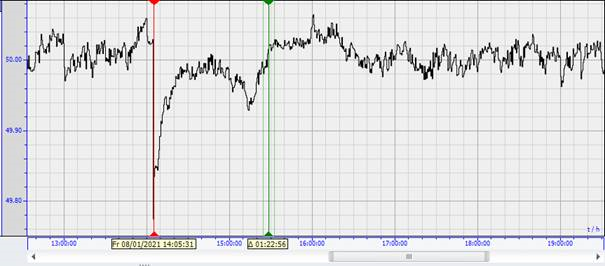Critical infrastructure: EPPE records the course of massive problems in the European power grid!
 -
12. avril 2021
-
Engineering & Services,
Power quality analysers
-
12. avril 2021
-
Engineering & Services,
Power quality analysers
The European power grid dealt with major problems on 08 January 2021. An entire region in Eastern Europe was disconnected, and in some cases experienced power outages. The European power grid is part of the critical infrastructure (CRITIS). The Austrian Federal Army had already warned in January 2020: "A Europe-wide blackout is to be expected within the next 5 years!“
On 8 January 2021 at around 14:05, a frequency deviation of around 250 mHz occurred in the synchronized European high-voltage electricity grid. As a result, the region of south-eastern Europe was disconnected from the European interconnected grid.
A cascade of failures of equipment, such as power lines and switchgear in south-eastern Europe, led to massive problems within the European power grid. According to the report, the near-blackout in large parts of Europe was triggered by a transformer station in Ernestinovo, Croatia. Initial investigations stated at 14:04 an overcurrent protection device on a 400-kilovolt bus bar coupler in the substation tripped, causing it to switch off automatically. This also interrupted two extra-high voltage connections that carry electricity from the Balkans to other parts of Europe; affecting the lines to Žerjavinec (Croatia) and Pecs (Hungary) in the north-western direction. The result was that within less than 50 seconds the European power grid split into two areas: the northwest, which lacked 6.3 GW of generation capacity, and the southeast, which had a corresponding surplus.
In some regions there were visible problems. For example, lamps in households and on the streets have lit up or went out, and electrical appliances turned on and off. The radio station RFI România reported power cuts in parts of Romania. The frequency drop led to consequential disturbances at various infrastructure operators, such as the Vienna airport and hospitals, which triggered the emergency power supply. There was also a serious incident at Vienna Airport, where hundreds of hardware parts were destroyed and damage amounting to several hundred thousand euros was caused. Approximately one hour after the disconnection, the two power grids were resynchronized.
Exact sequence of the disturbance
At 14:05 (CET) the frequency in the north-western power unit dropped to 49.74 Hz. After about 15 seconds, it stabilized at 49.84 Hz, which is still within the permissible band for deviations of plusminus 0.2 Hz. At the same time, the frequency in the south-eastern area jumped to 50.6 Hertz before stabilizing at a value between 50.2 and 50.3 Hz.
The disconnection of the sub-grid had a clear impact on the grid frequency. Thus, at (14:04:55 local time CET), the grid frequency dropped from about 50.027 Hz to a minimum of 49.742 Hz within 14 seconds. This left the normal control range of 50.000 Hz ±200 mHz. The first stage of the schedule (activation of power reserves) was achieved. Reconnection to the interconnected grid at 15:08 CET, on the other hand, had no effect on the grid frequency.


Comments are disabled for this post.
0 comments